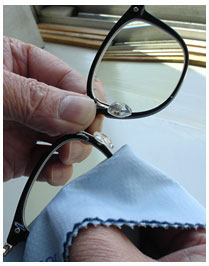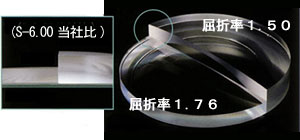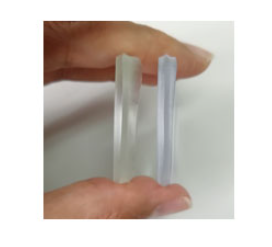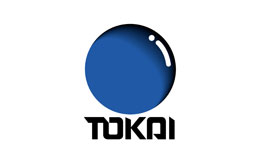This time, we would like to give you some advice on how to select eyeglass lenses “suitable for the use of a smartphone.”
Recently, we have received an increasing number of inquiries about “whether eyeglasses for smartphones are available.” Suitable for smartphones” in a word does not have any definition, and there are some different points of view depending on the generation or the situation of use.
This theme may take a considerable time to explain, and we are going to separate it into four parts.
When we consider the situation of “looking at a smartphone,” several “troubles” come to mind.
- I do not feel any inconvenience, but I somewhat feel eye strain when I look at my smartphone for a while. – A
- When I realized it, my eyes were farther away from my smartphone. – B
- When I use the current progressive lenses, I need to look at my smartphone with my chin drawn in, and this posture “really gives the impression that I have presbyopia.” I hate it. – C
- I have presbyopia, and it is therefore difficult for me to use a smartphone. – D
- I am concerned about harmful light, such as blue light. – E
These “troubles” can be simply classified as follows:
- Eye strain induced by staring at close proximity – A, B, E
- Difficulty of use due to “presbyopia” anyway – C, D, E

The symptom of (1) occurs to people in their 20s to early 40s. The expression “eyeglasses for smartphones” frequently refers to people of this age group in general. The symptom of (2) is a trouble with people in their late 40s and older ages. The symptom of (1) can be alleviated by eyeglasses to some extent, but it is difficult to deal with it as people get older. And E is a trouble common to (1) and (2). Smartphones also produces blue light frequently, and it is desired to reduce it even just a little.
From here, we consider what lenses are suitable for each of the troubles above in order, but before it, let us briefly run through near vision (looking at near objects) and presbyopia.
The act of “looking at near objects” is the work of adjusting focus using a muscle (ciliary muscle) of the eyes. The eyes focus on near objects by contracting the ciliary muscle and expanding the crystalline lens, which functions as a lens. The eyes focus on nearer objects as the crystalline lens further expands, but this function requires stronger power. In this state, the ciliary muscle keeps on working and becomes tense. Like other muscles, the ciliary muscle causes muscular fatigue, or “eye strain,” as it is used for a long time. To put it extremely, presbyopia is the state that “the eyes cannot focus on near objects” because this ciliary muscle weakens and the crystalline lens also deteriorates and becomes stiff. Once they are deteriorated, it is almost impossible to improve them. For this reason, lenses for artificially helping the eyes focus on near objects (reading glass lenses or progressive lenses) are required.
Keeping these points in mind, let us consider lenses suitable for (1) and (2).

(1) “Eye strain caused by staring at close proximity”
It is said that the distance at which one looks at a smartphone is approximately 20 cm.
In particular, when viewing websites or when it is not necessary to enter letters, this distance becomes very short. The distance is approximately 33 cm on average during reading or approximately 45 cm on average when using a personal computer. Compared to them, the viewing distance to a smartphone is considerably short. As mentioned earlier, focusing on nearer objects means using more muscles, and people feel stronger strain than the strain they feel in other short-distance work.Even many people in their 20s and 30s somehow feel eye strain although they are not so old that they develop presbyopia.People in their early 40s may have felt shocked, imagining that they have finally developed presbyopia!
This also results from excessive strain on the muscle (ciliary muscle) of the eyes. If the ciliary muscle excessively works, it becomes strained and stiff, and the eyes consequently fail to focus on near objects and develop a symptom like presbyopia.This is “smartphone presbyopia” we frequently hear it nowadays.
Then, how should you deal with it?
The answer is preventing the muscles of the eyes from excessively working, or assisting the function of the eyes. TOKAI OPTICAL offers the eye assist lens “REST.”
*For details, click here: REST Series
To learn more about REST, click here!↓↓↓
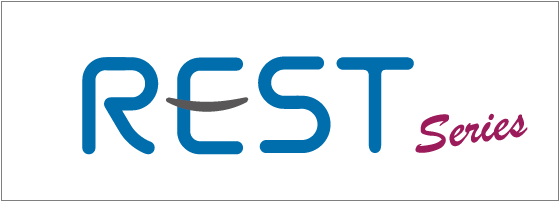
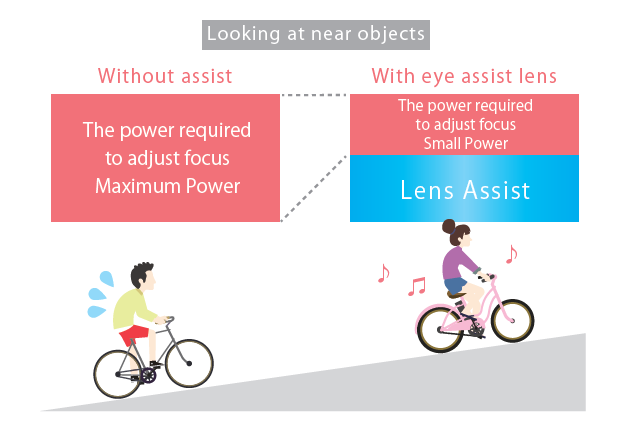
As shown in the image diagram shown above, this lens has the excellent function of “preventing excessive working” = “reducing eye strain” by artificially assisting the muscles (amplitude of accommodation) that should be used fundamentally. The upper half of the lens is a lens for ordinary use, and the lower half is an “assist area” provided with mild “power to focus on near objects.” Since the lens has a power change band, the user feel slight sway or distortion when he/she looks sideways. However, the design of the lens is evolving, and we think you can use it in the same manner as eyeglass lenses for ordinary use.
Eyeglass lens manufacturers release lineups of glasses featuring the function of “assisting” or “supporting” the amplitude of accommodation. Today, people’s lifestyles are changing and they mainly work on and look at smartphones as well as personal computers and other devices at short distances, and these lenses find a wider range of applications accordingly. Please consult a nearby eyeglass store.
In addition, if you are myopic, using “eyeglasses used in the past” is another solution when looking at your smartphone at home. Myopia, in other words, is an “eye that cannot see far but can clearly see near objects.”
In terms of focus, myopic eyes cannot see far but inevitably focus on near objects, compared to people with good eyesight. Wearing eyeglasses means making the eyes artificially focus on far objects (contact lenses also function in the same manner). Contrary to it, focusing on far objects makes it difficult for the eyes to focus on near objects, and consequently requires additional muscles (amplitude of accommodation). “Eyeglasses used in the past,” in many cases, have lower power, or weak power to focus on far objects than the eyeglasses currently used, and these old eyeglasses help the eyes focus on near objects more easily than the eyeglasses currently used.
*Note) The power of your eyes may have significantly changed, and the condition of the eyes is different among individuals. Please note that the abovementioned example merely refers to “many cases” in general.
Although explained briefly, this is how to “deal with eye strain caused by staring at close proximity,” which is a symptom people in their 20s to early 40s frequently feel.


